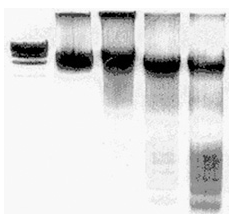Archival Notice
This is an archive page that is no longer being updated. It may contain outdated information and links may no longer function as originally intended.
Home | Glossary | Resources | Help | Contact Us | Course Map
It is hard to determine all of the causes of inhibition on the PCR reaction. The PCR process can be affected by compounds that interfere with the interaction between DNA and Taq polymerase, and thus inhibit the reaction. Many inhibitors are removed during the extraction process through ethanol precipitation or the use of a Microcon® or Centricon® centrifugal filter unit. However, some inhibitors co-elute with the DNA, which may lead to PCR inhibition. A number of inhibitors are contained in the samples themselves, while others can be introduced by the substrate or the analysis process. The presence of inhibitors can result in loss of data or results that could be mistaken for degradation. We can classify sources of inhibition into three groups:
- Internal, or those found in body fluids.
- Substrates, or those arising from the materials on which the blood stain or other source of DNA has been deposited.
- Other sources, such as reagents and materials used in the analysis.
Internal
Many body fluids contain substances that can inhibit PCR:01
|
Table of Biological Substances and Inhibitors |
||
|
Biological Substance |
Inhibitor |
Comment |
|
Blood |
The amplification of blood samples can be significantly reduced or blocked by natural components of blood, such as heme, and immunoglobulin G. Hemin, a hemoglobin derivative, and its breakdown products, bilirubin and bile salts, are also found to be PCR inhibitors. |
|
|
Vaginal Samples |
Bacteria Microorganisms |
Bacteria and microorganisms are commonly found in vaginal, fecal, and buccal samples. Note: these can also be found in other biological samples found at crime scenes. |
|
Buccal Samples |
||
|
Fecal Samples |
||
|
Hair Tissue |
Melanin, a pigment that affects skin, eye, and hair color, can inhibit PCR. |
|
|
Bone Teeth |
Ca2+ |
Ca2+ is commonly found in bone and teeth and is known to interfere with Mg2+ concentration, which in turn may affect the activity of Taq polymerase. |
|
Semen |
Polyamines |
Spermine and spermidine (polyamines originally isolated from semen) are found in ribosomes and living tissues, and can inhibit PCR. |
|
Urine |
Urea |
Urea, a chemical found in urine, can inhibit PCR. |
Substrates
Some of the substrates that contain inhibitors are:
|
Table of Substrates and Inhibitors |
||
|
Substrate |
Inhibitor |
Comment/Example |
|
Textile dyes |
Textile dyes |
Indigo dye used to color denim |
|
Fabrics |
Leather |
|
|
Environmental Samples |
Humic compounds Heavy metals |
Soil02 |
|
Food Constituents
|
Organic compounds Phenolic compounds Glycogen Fats Ca2+ |
Many food products, such as milk, contain inhibitors, like Ca2+. However, forensic scientists have had success in developing DNA profiles from saliva left on food or drink containers.01 |
Other Inhibitors
Inhibitors can be introduced in the collection and analysis processes or at the crime scene
|
Table of Other Inhibitors |
||
|
Source |
Inhibitor |
Comment |
|
Extraction Chemicals |
Phenolic compounds from the organic extraction Chelex resin Salts Guanidine Proteases Organic solvents Phosphate buffers Detergents (such as Sodium Dodecyl Sulfate (SDS)) |
Reagents commonly used in the purification of nucleic acids are inactivators of DNA polymerases. Phenol or Chelex resin left with the extracted DNA can inhibit the PCR process. |
|
Anticoagulants |
EDTA and heparin
|
Known blood reference samples are collected in tubes containing anticoagulants. |
|
Powder |
Glove powder |
Many forensics scientists use powdered gloves. |
|
Laboratory plastic ware |
PCR tubes |
It has been reported that an inhibitory substance can be released from polystyrene or polypropylene upon exposure to ultraviolet light. |
|
Plant and food products |
Pollen Cellulose Plant polysaccharides Ca2+ |
Biological material can be deposited on plants and food. |
Additional Online Courses
- What Every First Responding Officer Should Know About DNA Evidence
- Collecting DNA Evidence at Property Crime Scenes
- DNA – A Prosecutor’s Practice Notebook
- Crime Scene and DNA Basics
- Laboratory Safety Programs
- DNA Amplification
- Population Genetics and Statistics
- Non-STR DNA Markers: SNPs, Y-STRs, LCN and mtDNA
- Firearms Examiner Training
- Forensic DNA Education for Law Enforcement Decisionmakers
- What Every Investigator and Evidence Technician Should Know About DNA Evidence
- Principles of Forensic DNA for Officers of the Court
- Law 101: Legal Guide for the Forensic Expert
- Laboratory Orientation and Testing of Body Fluids and Tissues
- DNA Extraction and Quantitation
- STR Data Analysis and Interpretation
- Communication Skills, Report Writing, and Courtroom Testimony
- Español for Law Enforcement
- Amplified DNA Product Separation for Forensic Analysts



